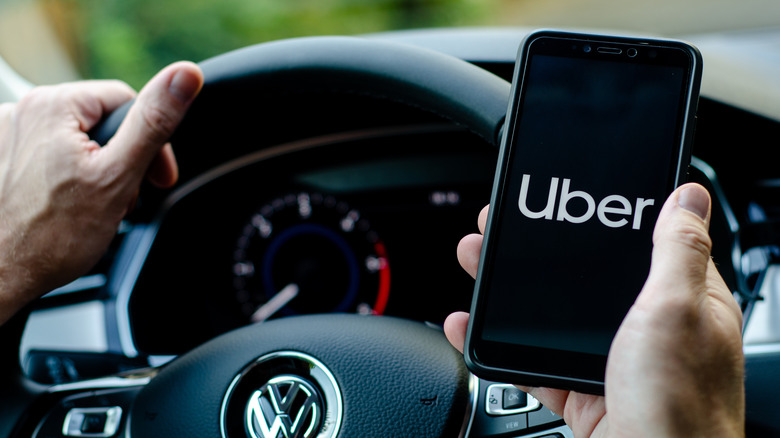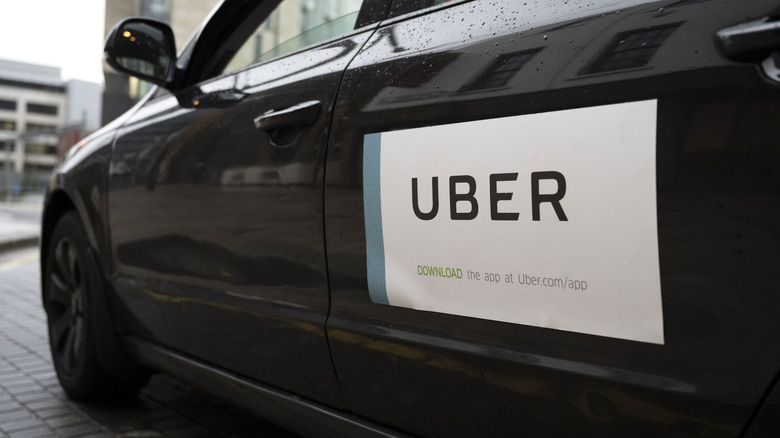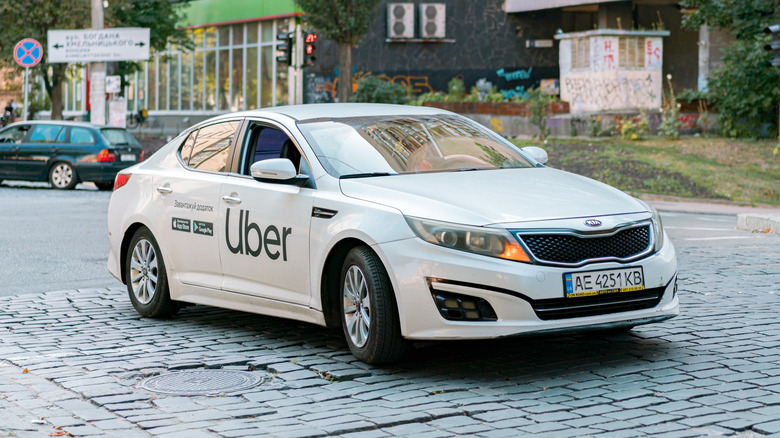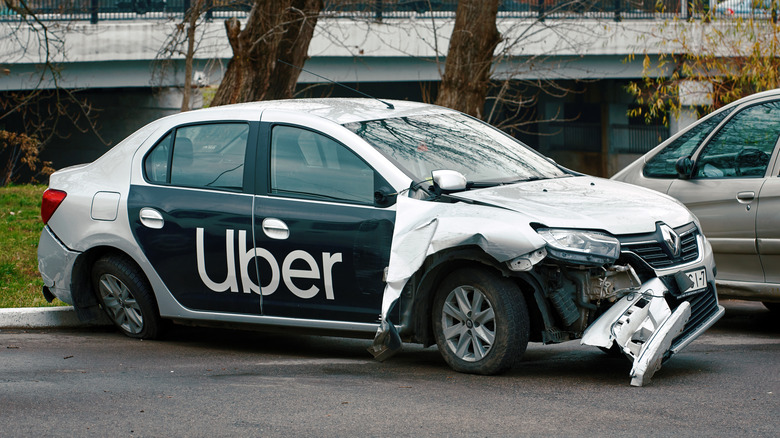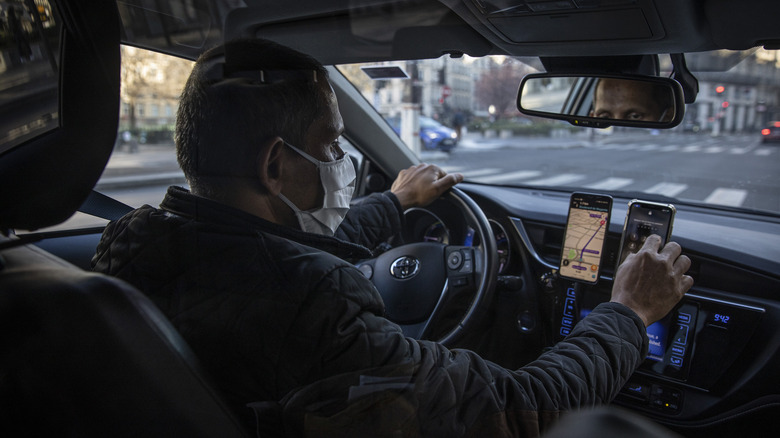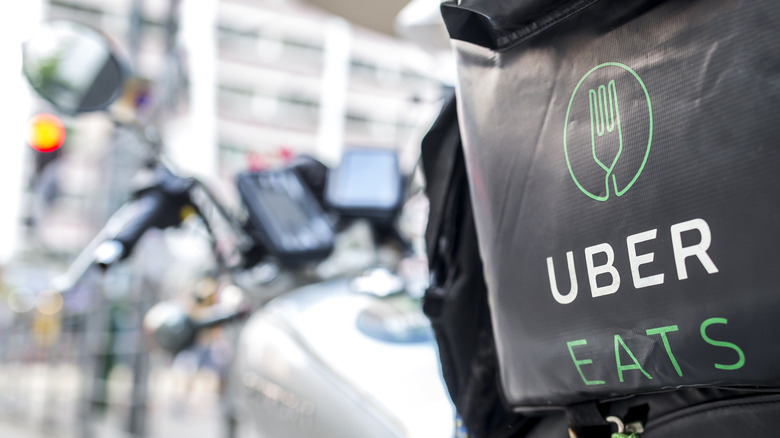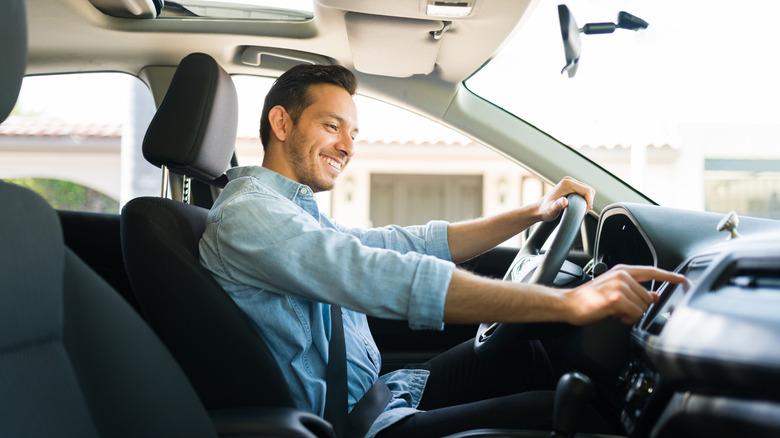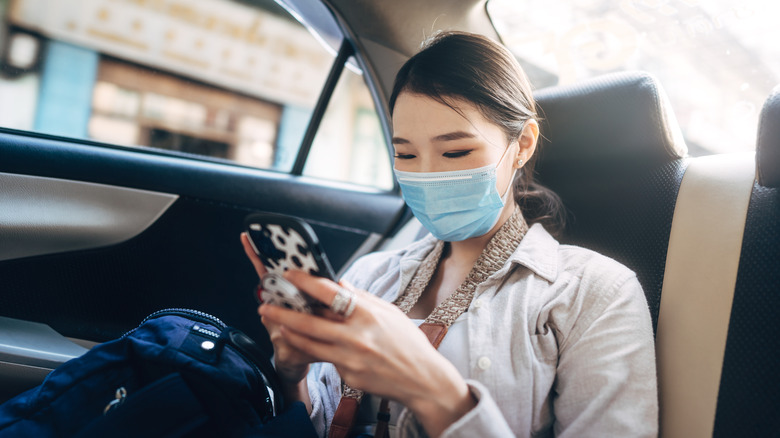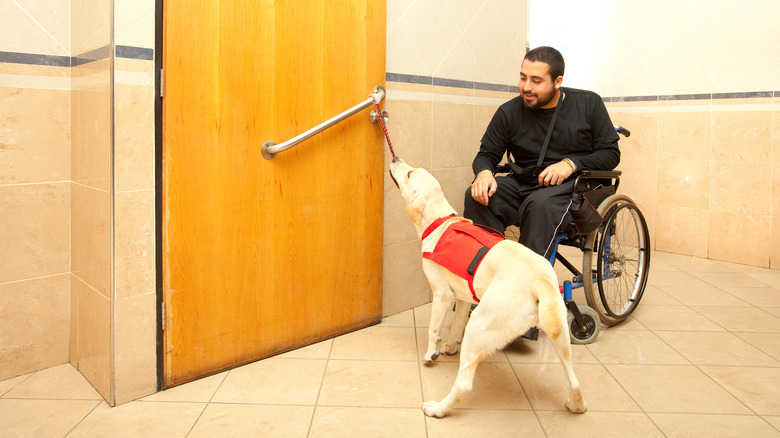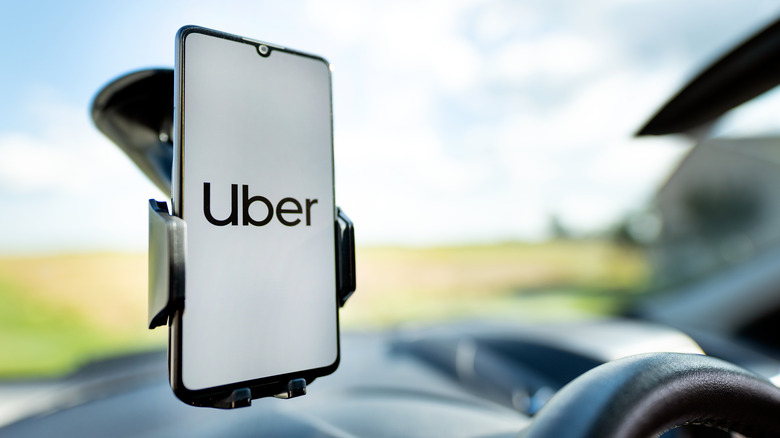Rules You Have To Follow When You Drive With Uber
Since it was founded in 2009, rideshare platform Uber has quickly risen to become the premier app in its sector, fending off competition from rivals like Lyft and Ola. The company's explosive ascent to the top has been shrouded in controversy, with Uber's former CEO Travis Kalanick even forced out of the company in dramatic fashion in 2017. More recently, the company has been left dealing with the fallout of a cyberattack, which at the time of writing is still under internal investigation to determine exactly which of its systems have been compromised.
It might be a troubled firm, but Uber continues to gain popularity each year, and it's rapidly expanding to reach an ever-growing list of cities both across the U.S. and in international markets. Anyone looking to make some extra cash and sign up to drive for Uber should be aware of the rules that drivers have to agree to, and there are plenty of them. Drivers found to be breaking any of these regulations are likely to be kicked off the platform, losing potential earnings, and in some cases, even committing offenses that are punishable by law.
Display a sticker or sign
Perhaps the most self-explanatory requirement for Uber drivers is to always display a sign that clearly indicates that they're a rideshare driver. This is necessary for a variety of reasons: For starters, riders need to be able to clearly pick out their ride at busy pick-up points, otherwise, there's a chance they'll end up in the wrong taxi or even worse, trying to get into a random person's car. The second reason is that some state authorities simply require it, and will prosecute drivers who don't have an appropriate sticker or sign displayed.
Finally, clearly displaying a rideshare logo is important when entering certain restricted areas like airport pickup lanes. Drivers are solely responsible for following all of the regulations of the airport they're driving to, and if they're not showing an appropriate sign, there's a good chance they'll be kicked out of taxi-only areas, causing delays for both the rider and the driver. And anyway, airport pickups are enough hassle to begin with, although Uber has taken steps to address this in recent years. One such measure the firm has implemented in select locations is allowing riders to get in the first available Uber using a six-digit PIN code instead of waiting for their specific car to arrive. For now, it's only available in selected airports around the U.S., but it should be rolled out across the country soon at high-traffic locations.
Drive a car that's less than 15 years old
The requirements for eligible vehicles vary slightly from state to state, but generally, an Uber car must be less than 15 years old, have four doors, and a minimum of five seats with seatbelts. There are no make or model restrictions, although, of course, some makes will be more naturally suited to being Ubers than others. Any car with a reputation for unreliability, for example, is probably not a good choice to use as a taxi. That's why so many Uber drivers choose trusted models from Toyota, Honda, or similarly dependable brands.
Cars that meet these minimum requirements will be able to offer UberX rides, but other, higher-paid categories are available for drivers with suitable vehicles. Drivers wanting to pick up UberXL rides need at least seven seats with seatbelts, although no vans, box trucks, or similar vehicles are allowed. It's also worth noting that Uber does not permit any form of seating modifications, including aftermarket seats or even non-standard seatbelts. Salvage title cars, or those with existing external taxi branding, are also not allowed.
Make sure you have appropriate insurance
Another key thing drivers need to check before their first ride is that they have an appropriate insurance policy. The requirements for what policy is needed vary from state to state, so it's important to check with Uber's website before accepting that first ride. Uber provides insurance for drivers when they're waiting for rides or completing them, but that policy does not cover any time when the driver is not actively working for the company, so a separate individual policy is also required.
While logged onto the app or waiting for a ride request, Uber's insurance policy covers up to $50,000 in bodily injury per person or $100,000 per accident. Up to $25,000 in property damage is also covered per accident. While en route to pick up deliveries or during trips, Uber provides up to $1,000,000 third-party liability, alongside comprehensive and collision insurance up to the value of the car minus a $2,500 deductible. These figures apply to every state apart from New York, where local rules mean the policy doesn't fully apply.
Abide by driving-hour limits
Both state and local regulations sometimes impose limits on the number of hours a driver can drive during a given period. To help stay within these limits, Uber's app warns drivers when they're approaching their limit, and then again when they've been on the app for the maximum amount of time. The driver is then forced to log off, but when they've been offline for a certain period of time, the limit resets and they are allowed to accept requests again.
Not every state enforces rules like this, and in those that don't, drivers often end up working very long hours to earn enough money to pay their bills. A series of strikes and walkouts took place throughout 2021 to protest against these poor working conditions, although the results of those strikes were mixed. Long hours as a full-time Uber driver is very much part of the job, but the company makes sure to never let its drivers go over legal limits in states that have such laws, so it's well worth checking the laws of your state before you start.
Park carefully when picking up passengers or deliveries
When working for Uber, actually driving is only part of the job. Equally important is picking up riders or deliveries, both in a timely manner and in a safe one. Local parking laws can affect where drivers are allowed to stop their cars to pick up riders, and it's up to the driver to find somewhere safe to stop if they're in a restricted area. This is often more of a problem for Uber Eats drivers, who frequently need to park near restaurants to pick up orders, but only for short periods of time. Alongside Uber Eats, the company now offers grocery deliveries in over 400 cities across the U.S. This further complicates the parking situation for time-strapped drivers, especially in crowded urban areas where spacious parking lots can be tricky to come by.
Uber says it investigates any incidents of parking violations or low-speed collisions during pickups, and if the driver is found to be at fault, they risk being kicked off the platform. It makes a particular point of discouraging drivers from blocking bike lanes to pick up riders, as this is one of the most common ways that they can be ticketed.
Meet the minimum threshold for driver experience
Considering the myriad other rules and regulations that Uber drivers have to follow, the rules around the driving experience are comparatively relaxed. Drivers over the age of 25 only need a minimum of one year's driving experience in the U.S., although anyone under 25 will need three years' worth of provable experience. International driving licenses are not allowed, but technically anyone over the minimum age to drive in their state is permitted to sign up for Uber and start driving.
To complete the signup process, drivers need to show proof of residency, proof of vehicle insurance, and provide a profile photo, and then pass a standard background check. This check includes a Motor Vehicle Report (MVR) and a criminal background check, alongside any other checks that may be relevant in certain states. There is no credit check, so drivers with a shaky financial history won't need to worry. These checks are not carried out by Uber themselves but by a third-party provider, and drivers won't be able to accept rides until they pass them.
Premier drivers need a luxury car
For riders seeking the most premium experience, Uber has a Premier tier that costs more, but provides the best possible experience. In order to be eligible to drive for this tier, drivers have to have at least 250 trips under their belt, with an average rating of at least 4.85 stars across them. They also have to drive a suitably luxurious vehicle, which must be newer than six years old and have a leather interior. After meeting these requirements, they can look forward to higher rates, but with the expectation that their riders will expect more than a regular UberX.
Another option for drivers and riders is Comfort, which requires drivers to own a more roomy car than standard. There is no set legroom measurement given on Uber's website, with them only stating that cars must have "more legroom than smaller, compact cars." It's up to Uber's discretion which cars meet this requirement. Along with a bigger car, drivers who want to take requests for Comfort tier trips will need to have racked up at least 100 rides, with an average rating of 4.85 stars across them.
Accommodate service animals and assistive devices
As more and more riders sign up for Uber across the U.S. and abroad, the diversity of those riders also grows exponentially. Some riders require service animals or assistive devices to take with them on their trips, and Uber's rules dictate that drivers are not allowed to refuse a fare because of this. It is noted that there are no exceptions to the rule, even if drivers have allergies, a fear of animals, or particular religious beliefs. However, it's within the driver's right to ask what services an animal is trained to provide, and to refuse a ride if the animal is simply a pet.
Allowing riders to travel with pets is up to the discretion of the driver in most cities, and it's mandatory for riders to message the driver before pickup to double-check. But, there are a select number of locations that have been testing a feature called Uber Pet. This makes it easier for riders to find pet-friendly vehicles straight from their app, as riders can tick a box that says a pet will be accompanying them, and likewise, drivers can tick a box to exclude pets from their ride requests. Uber Pet costs riders on average an extra $3-5 per trip, which offers drivers an incentive to sign up for the scheme.
Don't do anything Uber considers fraudulent activity
Above all else, Uber values honesty and transparency from its drivers and quickly moves to ban anyone suspected of misconduct. This includes anything obviously illegal, like money laundering, falsifying an identity, and suchlike, but it can also cover misuse of promotions or falsely disputing charges. It also covers "actions intended to disrupt or manipulate the normal functioning of the Uber platform," which is a bit of a catch-all policy for drivers trying to game the system in any way.
Alongside fraud and illegal activity, Uber also has strict policies against harassment, and violating these policies will result in immediate dismissal. These harassment policies apply to both riders and drivers and cover everything from asking relationship-based questions to explicit comments or gestures. It seems like not every driver follows this policy, with a lawsuit being filed in July 2022 that detailed over 500 alleged instances of sexual assault, but in general, reports of misconduct by drivers remain rare.
